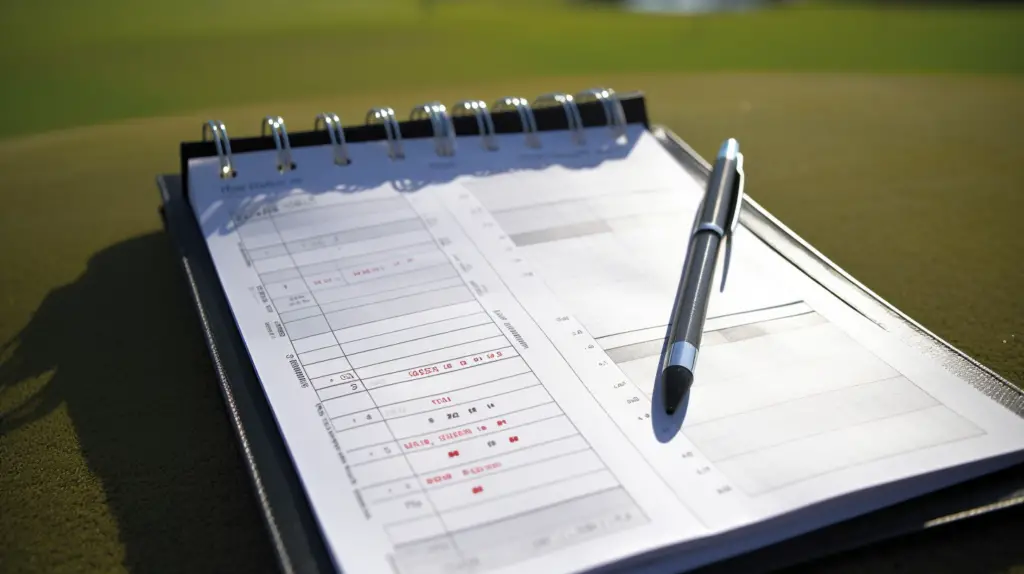Last Updated on October 27, 2023
Golf is a complex game with many rules, and keeping track of your score can be one of the most daunting aspects. It’s not as simple as just counting up how many strokes you’ve taken – there are various ways to accurately mark a golf card so that your performance can be tracked correctly. But don’t worry. We’ll show you exactly how to score a golf card in this blog post, along with some tips on improving your scores and avoiding common mistakes when marking down your results. So grab yourself a pencil and get ready for all the knowledge you need about scoring a golf card.
Table of Contents:
What Is a Golf Scorecard?
A golf scorecard is an essential tool for any golfer. It helps track your progress and can be used to compare scores with other players. A scorecard typically includes the player’s name, the course name, the date of play, and a list of holes with par values. The player then records their individual scores on each hole as they go along.
The most important thing to remember when using a scorecard is that it should always reflect accurate information about your game. This means recording every stroke taken on each hole—including penalty strokes—and noting any special rules or conditions that may have been in effect during the round (such as playing from a different tee box).
Keeping track of your scores over time can help you identify areas where you need improvement and set goals for yourself. You can also use your scorecards to calculate handicaps, which are numerical representations of a golfer’s skill level compared to other players in their same age group or gender category. Handicaps are useful for setting up competitive games between players with similar abilities but may not necessarily be at the same skill level overall.
How to Mark Your Scorecard

Marking your scorecard is an important part of golf, and it can be confusing for beginners. To make sure you’re recording the correct scores, here are some tips on how to mark your scorecard.
First, record each hole’s par number at the top of the column. Par is a predetermined number of strokes that a golfer should require to complete a hole. For example, if the par for Hole 1 is 4, then you would write “4” at the top of that column in your scorecard.
Next, enter your individual scores as you play through each hole. A birdie means one stroke under par; bogey means one stroke over par; double bogey two strokes over par; triple bogey three strokes over par; and so on until you reach double eagle (four under) or higher scores, which are rare but possible. If you hit an ace (hole-in-one), mark it with an “X” or checkmark next to that particular hole’s score entry box in your card.
You also need to keep track of any penalty shots taken during play, such as out-of-bounds or lost ball penalties which will add additional strokes to your total for that particular hole. Mark these by writing “PEN” followed by the number of extra shots taken in parentheses beside where you wrote down your original shot count for that specific hole on your card (e.g., PEN (+2)).
Finally, tally up all nine holes’ worth of individual scores into one grand total at the bottom right corner before moving on to the next round. This final sum will give you a good indication as to how well or not you played throughout this round and can help inform future decisions when playing again later on down the line. Just remember not to get too caught up in what other people might think about their own performance compared to yours since everyone has different skill levels and preferences when it comes to golfing strategies.
Keeping Track of Handicaps
Handicaps are a great way to measure your golfing ability and track your progress. A handicap is the number of strokes you receive from the course’s par rating, which is determined by considering factors such as difficulty level, length of holes, and terrain. The lower your handicap, the better golfer you are considered to be.
To calculate your handicap, you must first record all of your scores over a period of time on different courses with varying levels of difficulty. This will give you an average score for each round that can then be used to determine what kind of handicap you should have at any given course or set-up.
Once this information has been collected, it can be entered into an online system or app that will generate a Handicap Index (HI). This HI takes into account all rounds played over the past 12 months and gives an overall indication of how well someone plays compared to their peers who also play regularly on similar courses with similar conditions.

The HI can then be used in tournaments and other competitive events where players compete against one another based on their respective HIs rather than just raw scores. It also allows players to compare themselves against others more accurately since everyone’s playing conditions may not always be equal due to weather or other factors beyond their control.
In addition to helping players keep track of their performance over time, keeping tabs on one’s own HI also helps them identify areas they need improvement in so they can focus their practice sessions accordingly. By tracking both individual rounds as well as overall trends in performance over time using a Handicap Index system like USGA’s GHIN (Golf Handicapping Information Network), golfers have access to valuable data that can help them improve their game faster than ever before.
Conclusion
Golf is a game of skill and strategy, but it’s also important to know how to correctly mark your scorecard. With the right knowledge and practice, you can improve your golf game by learning how to properly score a golf card. Remember that keeping track of your handicap is key for improving over time, as well as avoiding common mistakes when scoring. With these tips in mind, you’ll be able to master the art of scoring a golf card.



